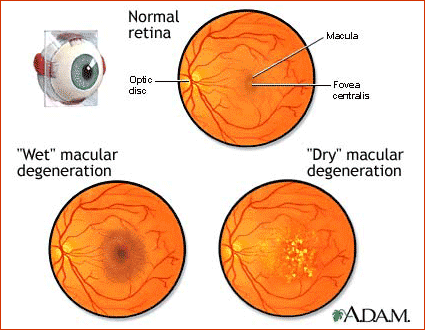There are two types of age-related macular degeneration (AMD). One form is known as “wet” and the other is “dry”. It is possible to experience both forms at the same time, in one or both eyes. It is not uncommon for a patient with the “dry” form to develop the “wet” form later. The onset and progression of either type do not follow any particular pattern. In its earliest stages, AMD can be difficult to diagnose. Sometimes it progresses so slowly that people do not notice a change in their vision. Years may go by before they see an ophthalmologist or eye care professional. In other cases, the deterioration is very rapid and can appear to happen overnight.

Retina of an Eye with Dry AMD
This most common type of AMD affects 90% of the people who have the condition. In the dry form, there is a breakdown or thinning of the retinal pigment epithelial cells (RPE) in the macula. These RPE cells are important to the health of the retina. They are light sensitive and contain hundreds of photoreceptors. The death or degeneration of these cells is called atrophy. Hence, dry AMD is often referred to as atrophic AMD. It is characterized by the presence of drusen (dots of yellow crystalline deposits that develop within the macula) and thinning of the macula. Dry or atrophic MD reduces one’s central vision and can effect color perception. Generally, the damage caused by the “dry” form is not as severe as that of the “wet” form. Unfortunately, there is no proven cure or treatment.
Retina of an Eye with Wet AMD
This is the more severe type of AMD. Although it afflicts only 10 percent of those who have the condition, it accounts for 90 percent of the blindness caused by this disease. With this type, the membrane underlying the retina thickens, then breaks. The oxygen supply to the macula is disrupted and the body responds by growing new, abnormal blood vessels. These begin to grow through the breaks of the membrane behind the retina towards the macula, often raising the retina.
To visualize this, imagine the roots of a tree growing and spreading until they actually uproot a sidewalk. Then imagine rainwater seeping up throughout the cracks. These abnormal blood vessels (the “roots) tend to be very fragile. They often grow, leak or bleed, causing scarring of the macula. This damage to the macula results in rapid central vision loss. Once this vision is destroyed, it cannot be restored.
Most patients report that their first sign of AMD was the rapid onset of prolonged, distorted vision. Straight lines like telephone wires and door frames appear to be wavy. If you notice any distorted or missing areas of vision, consult your ophthalmologist promptly. A certain percentage of patients with wet AMD can benefit from laser treatment if the blood vessel leak is caught early enough. Both traditional photocoagulation laser (a hot laser) and newer photodynamic therapy (using a photosensitive drug and a cold laser) can be effective in certain cases. There are even some new treatments under development for dry AMD.

